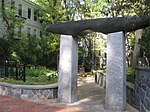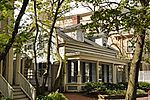Orson Welles Cinema
1969 establishments in Massachusetts1986 disestablishments in MassachusettsBuildings and structures in Cambridge, MassachusettsBurned buildings and structures in the United StatesCinemas and movie theaters in Massachusetts ... and 5 more
Culture of BostonHistory of Cambridge, MassachusettsOrson WellesRepertory cinemasTheatres completed in 1969
The Orson Welles Cinema was a movie theater at 1001 Massachusetts Avenue in Cambridge, Massachusetts that operated from 1969 to 1986. Showcasing independents, foreign films and revivals, it became a focal point of the Boston-Cambridge film community.
Excerpt from the Wikipedia article Orson Welles Cinema (License: CC BY-SA 3.0, Authors).Orson Welles Cinema
Massachusetts Avenue, Cambridge Cambridgeport
Geographical coordinates (GPS) Address Phone number Website Nearby Places Show on map
Geographical coordinates (GPS)
| Latitude | Longitude |
|---|---|
| N 42.369722222222 ° | E -71.111388888889 ° |
Address
Dunkin' (Dunkin' Donuts)
Massachusetts Avenue 1001
02138 Cambridge, Cambridgeport
Massachusetts, United States
Open on Google Maps









